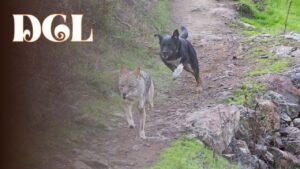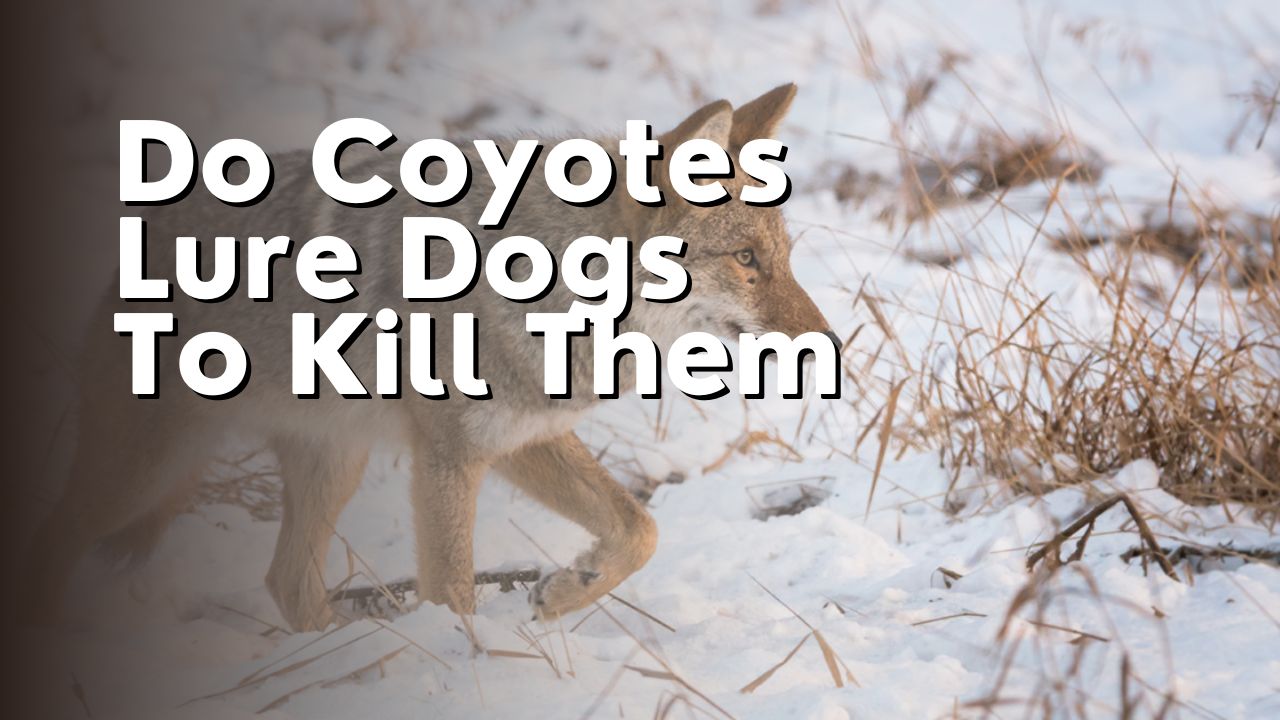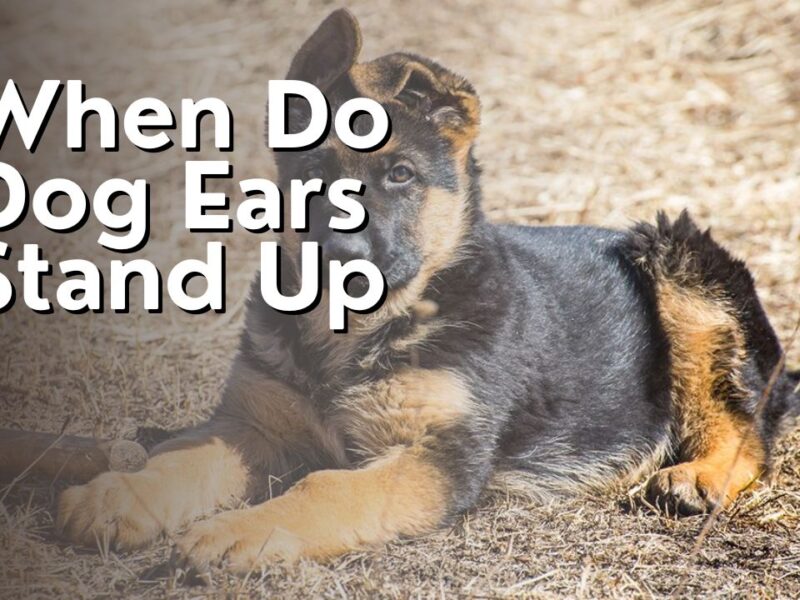Hey there! Have you ever wondered if coyotes really lure dogs to kill them? Well, let me tell you, I’ve done some digging and I’m here to shed some light on this topic. It’s a question that has sparked a lot of curiosity and concern among pet owners, and rightfully so. As someone who has always had a furry companion by my side, I understand the need to ensure their safety.
In this article, we’ll delve into the behavior and hunting habits of coyotes to better understand their interactions with dogs. We’ll debunk the myth of coyotes luring dogs and explore the reality behind these claims. Additionally, I’ll provide some valuable insights on how to protect your pets from coyote attacks and how to coexist peacefully with these wild creatures.
So, if you’re ready to separate fact from fiction and gain a deeper understanding of coyote-dog interactions, let’s dive right in!
Coyote Behavior and Hunting Habits
Coyotes have fascinating hunting habits and behaviors. These clever creatures are known for their ability to adapt to different environments and find food in various ways. One interesting behavior of coyotes is their use of luring techniques to catch their prey.
Coyotes are known to lure dogs or other animals closer to them, but it is important to note that their intention is not necessarily to kill them. Coyotes are opportunistic hunters, and they primarily feed on small mammals like rabbits and rodents. However, if a coyote feels threatened or if a dog wanders too close to their territory, it may defend itself or its resources.
When it comes to hunting, coyotes are highly adaptable and flexible. They have been observed using different strategies to catch their prey. Sometimes, they work alone, relying on their stealth and speed to surprise their target. Other times, they hunt in packs, using coordinated tactics to outsmart and catch larger prey.
Overall, coyotes are intelligent and resourceful animals. While there have been reports of coyotes luring dogs, it is important to understand that this behavior is not typical. Coyotes are generally more interested in smaller prey and avoid confrontations with larger animals.

The Myth of Coyote Luring
I’ve always been fascinated by the myths and popular beliefs surrounding coyote behavior. One myth that has intrigued me is the idea that coyotes lure dogs to kill them. This myth has been perpetuated for years, with stories of coyotes mimicking the sounds of distressed animals to lure unsuspecting dogs to their demise.
However, scientific evidence has debunked this myth. Research has shown that coyotes do not engage in such behavior. They are opportunistic predators that primarily hunt small mammals, birds, and insects. They are not interested in luring and killing dogs.
This myth likely originated from misunderstandings and misinterpretations of coyote behavior. Coyotes are known for their vocalizations, which can include a wide range of sounds. Sometimes, these vocalizations may sound similar to distressed animals. However, this is not an intentional lure but rather a natural part of their communication repertoire.
It is important to dispel this myth and understand the true nature of coyote behavior. By doing so, we can foster better coexistence with these fascinating creatures and appreciate them for who they truly are.
Origins and popular beliefs
Contrary to popular belief, there is an intriguing history surrounding the origins of the belief that coyotes lure dogs to their demise.
This myth has been passed down through generations and has become deeply ingrained in our collective consciousness. Many people believe that coyotes possess a cunning intelligence that allows them to manipulate dogs into dangerous situations.
Some theories suggest that this belief stems from ancient folklore, where coyotes were depicted as tricksters and shape-shifters. Others claim that it originated from actual encounters between coyotes and dogs, where the coyotes may have exhibited predatory behavior.
However, it is important to note that there is no scientific evidence to support the notion that coyotes intentionally lure dogs to kill them. This myth persists, nevertheless, perpetuated by sensational stories and urban legends.
Debunking the myth with scientific evidence
To debunk this myth, you’ll be amazed to learn that scientific evidence conclusively refutes the idea that coyotes intentionally entice dogs to their demise. Numerous studies have been conducted to investigate this claim, and they consistently show that coyotes do not lure dogs to kill them. In fact, coyotes generally avoid confrontations with larger predators, such as dogs. They are more likely to exhibit defensive behavior when they feel threatened or when protecting their territory.
To further illustrate this point, let’s take a look at the following table:
| Coyote Behavior | Explanation |
|---|---|
| Avoidance of Confrontation | Coyotes try to avoid interactions with larger predators, including dogs. |
| Defensive Behavior | Coyotes may exhibit defensive behavior if they feel threatened or when protecting their territory. |
| Natural Predation | Coyotes primarily prey on small mammals like rodents and rabbits, not dogs. |
As you can see, the scientific evidence clearly disproves the notion that coyotes intentionally lure dogs to harm them.
Understanding Coyote-Dog Interactions
In this discussion, I’ll explore the key points surrounding coyote-dog interactions.
Firstly, let’s delve into the territorial behavior of coyotes and how it may influence their interactions with dogs.
Coyotes are highly territorial animals, and they mark their territories with scent markings and vocalizations. They may view dogs as intruders in their territory, leading to potential conflicts. Understanding this territorial behavior can help us better comprehend the dynamics of coyote-dog interactions.
It’s important to note that not all coyotes will exhibit aggressive behavior towards dogs. Some coyotes may show curiosity or even fear when encountering dogs. However, there is always a possibility of aggressive encounters, especially if a coyote feels threatened or if it perceives the dog as a potential threat to its territory or offspring.
Now, let’s move on to some valuable tips for managing encounters between dogs and coyotes to ensure the safety of both species.
- Keep your dog on a leash: When walking your dog in areas known to have coyotes, it’s crucial to keep your dog on a leash. This will help you maintain control over your dog and prevent it from approaching or chasing coyotes.
- Avoid walking dogs during peak coyote activity: Coyotes are most active during dawn and dusk. If possible, try to avoid walking your dog during these times, as it reduces the chances of encountering coyotes.
- Be vigilant and aware of your surroundings: When walking your dog, stay alert and keep an eye out for any signs of coyotes nearby. Look for tracks, scat, or other indications of their presence. If you spot a coyote, calmly and slowly move away from the area.
- Make your presence known: If you encounter a coyote while walking your dog, make yourself appear larger by raising your arms and shouting assertively. This can help deter the coyote and protect your dog.
- Do not feed coyotes: Feeding coyotes can lead to habituation and increase the chances of conflicts. Avoid leaving food or water out in your yard that may attract coyotes.
Remember, understanding coyote behavior and taking necessary precautions can help ensure the safety of both dogs and coyotes in their shared environments.
Coyote territorial behavior
Coyotes exhibit territorial behavior, marking their territory with scent markings and vocalizations. This behavior is important for them to establish and defend their home range. Here are some interesting facts about coyote territorial behavior:
- Scent Markings: Coyotes use urine, feces, and glandular secretions to mark their territory. These scent markings serve as a clear message to other coyotes, warning them to stay away.
- Vocalizations: Coyotes have a wide range of vocalizations, including howls, yips, and barks. These vocalizations help them communicate with other coyotes, reinforcing their territorial boundaries.
- Boundary Patrols: Coyotes regularly patrol the edges of their territory to ensure that no intruders have trespassed. They leave scent markings and listen for any vocalizations from neighboring coyotes.
Understanding coyote territorial behavior is crucial when considering the interactions between coyotes and dogs. It’s important for dog owners to be aware of coyote territories and take necessary precautions to keep their pets safe.
Tips for managing encounters between dogs and coyotes
Tips for managing encounters between dogs and coyotes:
- Keep your dog on a leash when walking in areas where coyotes are known to roam, ensuring their safety during encounters. This is the most important tip for managing interactions between dogs and coyotes. By keeping your dog on a leash, you have control over their movements and can prevent them from approaching or engaging with coyotes.
- Avoid walking your dog during dusk or dawn when coyotes are most active. This reduces the chances of encountering them and minimizes potential risks.
- If you do come across a coyote while walking your dog, do not run away or turn your back on them. Instead, make yourself look big, shout loudly, and throw objects toward the coyote to scare them away. This assertive behavior can help deter the coyote and protect your dog.
- Always prioritize your dog’s safety during encounters with coyotes. Minimize any potential risks by following these tips and being vigilant while walking in areas where coyotes are present.
Protecting Your Pets from Coyote Attacks
Make sure to take precautions to keep your furry friends safe from potential coyote attacks. Coyotes are opportunistic predators and may see small pets, such as dogs, as potential prey. To protect your pets from coyote attacks, it’s important to be proactive and follow some simple guidelines.
Firstly, never leave your pets unattended outside, especially during dusk and dawn when coyotes are most active. Always supervise them when they are in the backyard or any other outdoor area. Additionally, keep your pets on a leash when you take them for walks, as this will help to prevent any unexpected encounters with coyotes.
Secondly, make your yard less attractive to coyotes. Remove any potential food sources, such as fallen fruits, garbage, or pet food left outside. Secure your garbage cans with tight-fitting lids and avoid feeding your pets outside. By eliminating these food sources, you reduce the chances of attracting coyotes to your property.
Lastly, consider installing a sturdy fence around your yard. Make sure the fence is at least six feet tall and extends partially underground to prevent coyotes from digging underneath. This will create a physical barrier and help keep your pets safe from coyote attacks.
By taking these precautions, you can significantly reduce the risk of coyote attacks on your beloved pets. Stay vigilant and prioritize their safety to ensure they are protected from any potential harm.

Coexisting with Coyotes
Living harmoniously with coyotes can be a rewarding experience if we understand their behavior and take appropriate precautions. Coyotes are highly adaptable animals and have successfully adapted to living in urban and suburban areas. To coexist peacefully with coyotes, it is important to follow some guidelines.
First, it is crucial to secure your property by ensuring there are no easy food sources for coyotes, such as unsecured garbage cans or pet food left outside. Additionally, keeping small pets indoors, especially during dusk and dawn when coyotes are most active, is essential.
Second, it is advisable to haze coyotes if they come into your yard or neighborhood. Hazing involves making loud noises, throwing objects, or using water hoses to scare them away. This teaches coyotes to associate humans with negative experiences and helps maintain their natural fear of humans.
Lastly, it is important to educate yourself and your community about coyote behavior. Understanding their natural instincts and learning to recognize signs of aggression or potential conflict can help prevent negative encounters.
By following these guidelines and respecting coyotes’ space, we can coexist with these fascinating creatures while minimizing any potential conflicts.
| Guidelines to Coexist with Coyotes |
|---|
| Secure your property |
| Keep small pets indoors |
| Haze coyotes if they come close |
| Educate yourself and your community |
Frequently Asked Questions
How can I tell if a coyote is luring my dog?
If I suspect a coyote is luring my dog, I would look for signs like unusual behavior or strange sounds. I would also keep a close eye on my dog and avoid letting them wander alone in areas known to have coyotes.
Are all coyotes capable of luring and attacking dogs?
No, not all coyotes are capable of luring and attacking dogs. While some coyotes may exhibit this behavior, it is not true for every coyote. It’s important to be cautious and aware of your surroundings when encountering coyotes.
Can coyotes climb fences or jump over them to reach my pets?
Yes, coyotes can climb fences and jump over them to reach my pets. It’s important to ensure fences are at least 6 feet tall and have no objects nearby that could help them climb.
Are certain dog breeds more at risk of being targeted by coyotes?
Certain dog breeds may be more at risk of being targeted by coyotes due to their size, behavior, or vulnerability. It is important for pet owners to be aware of their dog’s breed characteristics and take necessary precautions to protect them from potential coyote attacks.
What measures can I take to deter coyotes from approaching my property?
To deter coyotes from approaching my property, I can take several measures. These include securing garbage cans, removing any potential food sources, installing motion sensor lights, and building a fence around my property.
Conclusion
In conclusion, living alongside coyotes requires vigilance and proactive measures to protect our beloved pets. While there are myths about coyotes luring dogs to kill them, it is important to understand their behavior and hunting habits.
By keeping our dogs on leashes, securing our yards, and avoiding leaving food outside, we can minimize the chances of coyote attacks.
Coexistence is possible if we educate ourselves and take the necessary precautions. Let’s cherish our furry companions and ensure their safety in coyote territory.


